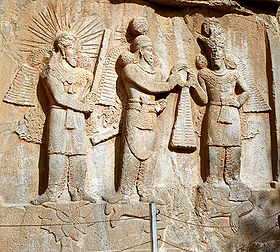
Ardashir II
Encyclopedia

He is believed by some to be the son and by others to be the brother of his predecessor, Shapur II
Shapur II
Shapur II the Great was the ninth King of the Persian Sassanid Empire from 309 to 379 and son of Hormizd II. During his long reign, the Sassanid Empire saw its first golden era since the reign of Shapur I...
(309–379). However, it is well-known that under the reign Shapur, Ardashir II had served as governor-King of Adiabene
Adiabene
Adiabene was an ancient Assyrian independent kingdom in Mesopotamia, with its capital at Arbela...
, where he had reportedly persecuted Christians
Christianity
Christianity is a monotheistic religion based on the life and teachings of Jesus as presented in canonical gospels and other New Testament writings...
.
However, the acts of brutality against Christians attributed to him severely contradict the unanimous view that he was the most kind and virtuous of the Sassanian rulers. Ardashir II was given the epithet "Nihoukar" or "Beneficient" by the Persians. The Arabs called him "Al Djemil" or "the Virtuous". According to the "Modjmel-al-Tewarikh," he took no taxes from his subjects during the four years of his reign, and thereby secured to himself their affection and gratitude.
Relations With Armenia
Soon after his accession, events in ArmeniaArmenia
Armenia , officially the Republic of Armenia , is a landlocked mountainous country in the Caucasus region of Eurasia...
seemed to occupy Ardashir's attention. Arshak II
Arshak II
Arshak II or Arsaces II, was the son of King Tiran and was himself king of Armenia from 350 to 367.- Reign :In the early years of Arshak's reign, he found himself courted by the empires of Rome and Persia, both of which hope to win Armenia to their side in the ongoing conflicts between them...
's son Pap
Pap of Armenia
Pap was king of Armenia of the Arshakuni dynasty from 370 to 374. He was the son of King Arshak II and is notorious for poisoning the Catholicos of Armenia Nerses the Great.-Ascendancy:...
had been murdered during Shapur's reign and the Romans
Roman Empire
The Roman Empire was the post-Republican period of the ancient Roman civilization, characterised by an autocratic form of government and large territorial holdings in Europe and around the Mediterranean....
had replaced him with a certain Varazdat
Varazdat
Varazdat |Latinized]] as Varasdates) was an Armenian prince who succeeded his uncle King Pap as King of Armenia in 374.-Appointment:...
who was a distant member of the Arshakuni family. However, real power was in the hands of a certain Moushegh
Musel Mamikonian
Musel Mamikonian, also spelled Mushegh was the Sparapet of Armenia under Pap and then, after Pap was killed, was the regent for his nephew Varazdat.While in the service of Pap, Musel was a key figure in defeating the invading Persian forces...
who appeared to be a noble in the Armenian court. Moushegh was suspected of having conspired with the Emperor of Rome and was murdered by Varazdat. This act roused the indignation of Moushegh's brother Manuel
Manuel Mamikonian
Manuel Mamikonian was the real leader of Armenia after the death of Varazdat.The Mamikonian family had long been the leading generals of Armenia, holding the title of Sparapet, basically a chief general....
who rebelled against Varazdat and with the support of Persia deposed him and placed upon the Armenian throne Zermandukht, the widow of Pap and Arshak III
Arshak III
Arshak III was the last king of the part of Armenia that was put under Roman domination by the Peace of Acilisene.Arshak III originally came to power as co-king with his brother Valarshak in 380 during Manuel Mamikonian's domination of Armenia...
, Pap's son, who made Manuel the Sparapet
Sparapet
Sparapet was a hereditary military rank that originated in the 2nd century BC, under the reign of King Artashes I, and was used in the Kingdom of Armenia and the Armenian Kingdom of Cilicia , was supreme commander of the armed forces. It was the equivalent of the Parthian Spahbod Sparapet was a...
or Commander-in-chief
Commander-in-Chief
A commander-in-chief is the commander of a nation's military forces or significant element of those forces. In the latter case, the force element may be defined as those forces within a particular region or those forces which are associated by function. As a practical term it refers to the military...
. In return for their services, Manuel allowed the Persians to maintain a garrison
Garrison
Garrison is the collective term for a body of troops stationed in a particular location, originally to guard it, but now often simply using it as a home base....
in Armenia.
But this arrangement did not work for long. A nobleman named Meroujan wrongly informed Manuel that the commandant
Commandant
Commandant is a senior title often given to the officer in charge of a large training establishment or academy. This usage is common in anglophone nations...
of the Persian garrison desired to capture him. Enraged, Manuel fell upon the ten thousand Persian soldiers stationed in Armenia and murdered them. But Manuel died soon afterwards and confusion followed. Desirous of maintaining peace in the borderlands, the Roman Emperor Theodosius I
Theodosius I
Theodosius I , also known as Theodosius the Great, was Roman Emperor from 379 to 395. Theodosius was the last emperor to rule over both the eastern and the western halves of the Roman Empire. During his reign, the Goths secured control of Illyricum after the Gothic War, establishing their homeland...
and Ardashir II decided upon a treaty. But Ardashir II died in 383 before the treaty could be signed. The treaty was eventually signed and ratified by his son Shapur III in the year 384.

